In this post, we will explore one of the most important concepts and presuppositions of NLP, that is the Map is not the territory. This understanding is the basis of our Cognitive Hypnotic Coaching™ and Cognitive Hypnotic Psychotherapy™ Programs.
Unraveling the Meaning: Map is Not Equal to Territory
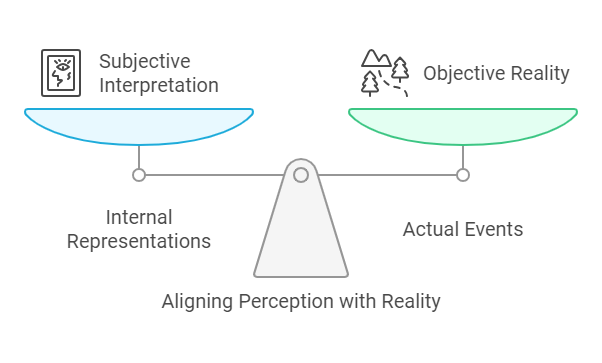
We’ve all experienced moments when our perception of a situation clashes with reality. It’s a phenomenon that highlights the fundamental difference between our internal representations (the map) and the actual events unfolding around us (the territory).
This concept, encapsulated in the famous phrase map is not equal to territory, holds profound implications for how we navigate life’s challenges.
The Origins and Evolution of a Powerful Concept
The phrase map is not equal to territory is attributed to Polish-American philosopher and scientist Alfred Korzybski, who introduced it in his seminal work Science and Sanity (1933). Korzybski’s work laid the foundation for the field of general semantics, which explores the relationship between language, thought, and behaviour.
Building upon Korzybski’s ideas, anthropologist and systems theorist Gregory Bateson further developed the concept, emphasizing the importance of recognizing the inherent limitations of our mental models and the dangers of confusing them with reality itself.
In recent years, neuroscientists and cognitive psychologists have continued to explore the implications of this concept, shedding light on how our brains construct internal representations and how these representations shape our perceptions, emotions, and decision-making processes.
The Map vs. Territory Example: A Revealing Anecdote
To illustrate this concept, let’s explore a relatable scenario. Imagine you spot a friend walking down the street, and you call out their name. Instead of responding, they seem to quicken their pace, leaving you puzzled and perhaps a little hurt. Your internal map might lead you to assume they’re deliberately ignoring you, triggering a whirlwind of self-doubt and speculation.
However, the territory – the actual reality – could be entirely different. Perhaps your friend was wearing headphones and didn’t hear you, or they were rushing to catch a bus. The problem you perceived existed solely within your internal representation, your map, while the territory remained unchanged.
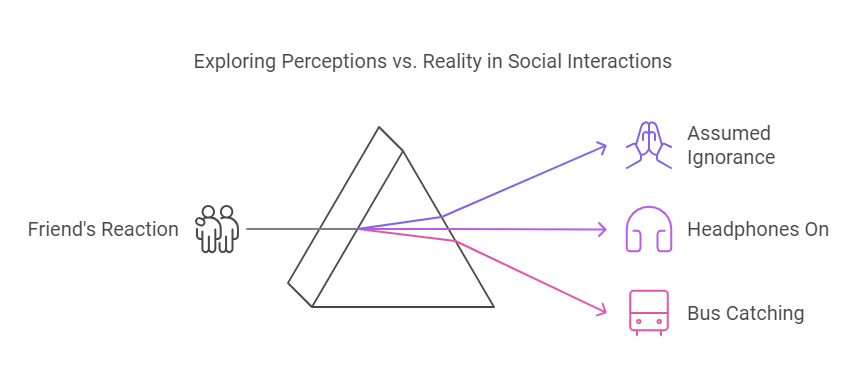
The Power of Questioning Your Map
This anecdote highlights the importance of questioning our internal representations and recognizing that our maps are not always accurate reflections of reality. By adopting a practice of self-inquiry, we can challenge our assumptions and gain a more objective understanding of situations.
One simple exercise can help cultivate this mindset: whenever you perceive a problem, pause and ask yourself, Is this problem really real, or is it just a part of my map? This simple question can initiate a profound shift in your perspective, allowing you to separate your subjective interpretations from the objective reality.
The NLP Presupposition: People Respond to Their Maps
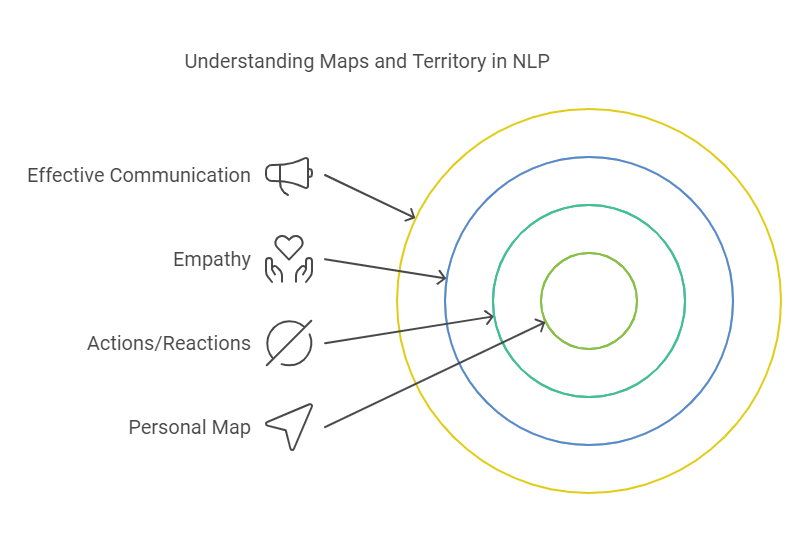
Another crucial aspect of understanding the map is not equal to territory concept is recognizing that people respond based on their internal representations, not reality itself. This principle, known as the NLP (Neuro-Linguistic Programming) presupposition, emphasizes that our actions and reactions are guided by our unique maps, shaped by our experiences, beliefs, and perceptions.
By acknowledging this presupposition, we can develop greater empathy and understanding for others’ perspectives, even when they differ from our own. It also encourages us to communicate more effectively by considering how our messages might be interpreted through the lens of another person’s map.
Related Concepts: Cognitive Distortions, Schemas, and Mental Models
The map is not equal to territory concept is closely related to several other psychological and cognitive theories that explore the interplay between perception and reality.
In Cognitive Behavioural Therapy (CBT), for instance, the concept of cognitive distortions refers to the systematic biases and errors in our thinking patterns that can lead to distorted perceptions of reality. Examples include overgeneralization, catastrophizing, and black-and-white thinking.
Similarly, the concept of schemas in psychology refers to the mental structures or frameworks that we use to organize and interpret information based on our past experiences. These schemas can shape our perceptions and influence how we process new information, sometimes leading to biased or distorted views of reality.
In the field of systems thinking, the concept of mental models is closely related to the map is not equal to territory idea. Mental models are the internal representations or beliefs that individuals hold about how the world works, and they can significantly influence decision-making and problem-solving processes.
By understanding these related concepts, we can gain a deeper appreciation for the complexities of human perception and the importance of recognizing the limitations of our internal representations.
Practical Applications for Psychologists and Coaches
For psychologists and coaches, understanding the map is not equal to territory concept is crucial for helping clients navigate the challenges they face. By recognizing the difference between their internal representations and objective reality, clients can develop greater self-awareness, emotional resilience, and problem-solving abilities.
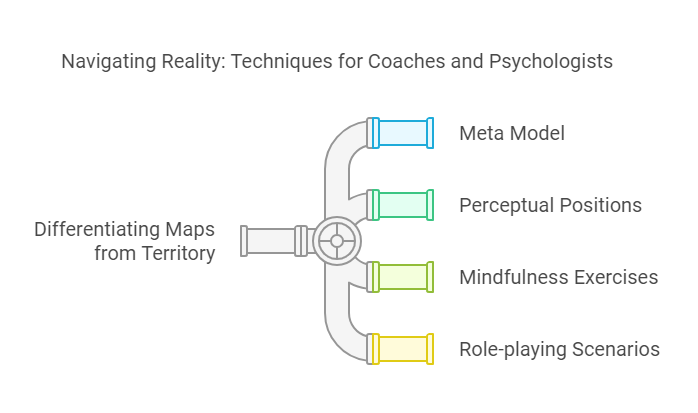
Here are some practical techniques that psychologists and coaches can use to help clients differentiate between their maps and the territory:
- Meta Model: This NLP technique involves asking specific questions to uncover the underlying assumptions, distortions, and deletions in a client’s language and thought patterns.
- Perceptual Positions: This exercise involves shifting perspectives and viewing a situation from different angles, helping clients recognize the limitations of their initial perceptions.
- Mindfulness Exercises: Practices like meditation and mindful observation can help clients cultivate a non-judgmental awareness of their thoughts and emotions, allowing them to separate themselves from their internal representations.
- Role-playing Scenarios: By acting out different scenarios, clients can experience alternative perspectives and gain insights into how their maps might differ from the territory.
Once clients can distinguish between their maps and the territory, psychologists and coaches can employ various techniques to help bridge the gap and align their internal representations with reality:
- Cognitive Restructuring Exercises: These techniques, commonly used in CBT, involve identifying and challenging irrational or distorted thought patterns and replacing them with more realistic and adaptive beliefs.
- Anchoring: This NLP technique involves associating a specific state or response with a particular stimulus, allowing clients to access desired emotional states or behaviours more readily.
- SWISH Pattern: This NLP technique helps clients replace unwanted behaviours or responses with more desirable ones by creating a vivid mental image of the desired outcome.
- Transformational Metaphor: By using metaphorical language and imagery, this technique can help clients reframe their perceptions and beliefs in a more empowering and constructive way.
- Guided Hypnotic Imagery: Through hypnosis and guided visualization, clients can access deeper levels of their unconscious mind and create new neural pathways that align with their desired outcomes.
Case Studies: Bridging the Gap Between Map and Territory
Case Study 1: Social Anxiety and the Fear of Rejection
Sarah, a 28-year-old marketing professional, sought help from a therapist to overcome her debilitating social anxiety. Through cognitive restructuring exercises and mindfulness practices, Sarah learned to separate her irrational fears of rejection (her map) from actual social interactions (the territory).
By challenging her distorted thought patterns and cultivating a non-judgmental awareness of her emotions, Sarah was able to recognize that her internal representations were often exaggerated and disconnected from reality. With the therapist’s guidance, she practiced role-playing scenarios and used anchoring techniques to associate positive emotions with social situations, gradually bridging the gap between her map and the territory.
Case Study 2: Executive Leadership and Overcoming Limiting Beliefs
John, a seasoned executive, sought coaching to improve his leadership skills and team management abilities. During the coaching sessions, it became apparent that John’s belief about his team’s incompetence (his map) was based on limited data points and anecdotal evidence rather than objective performance metrics (the territory).
The coach employed the Meta Model technique to uncover the underlying assumptions and distortions in John’s language and thought patterns. Through perceptual position exercises, John was able to view the situation from different perspectives, gaining insights into his team members’ motivations and challenges.
By using transformational metaphors and guided hypnotic imagery, the coach helped John reframe his limiting beliefs and create a more empowering mental model that aligned with the reality of his team’s capabilities and potential. This shift in perspective not only improved John’s leadership skills but also fostered a more positive and productive work environment.
Embracing Reality: The Path to Growth and Fulfillment
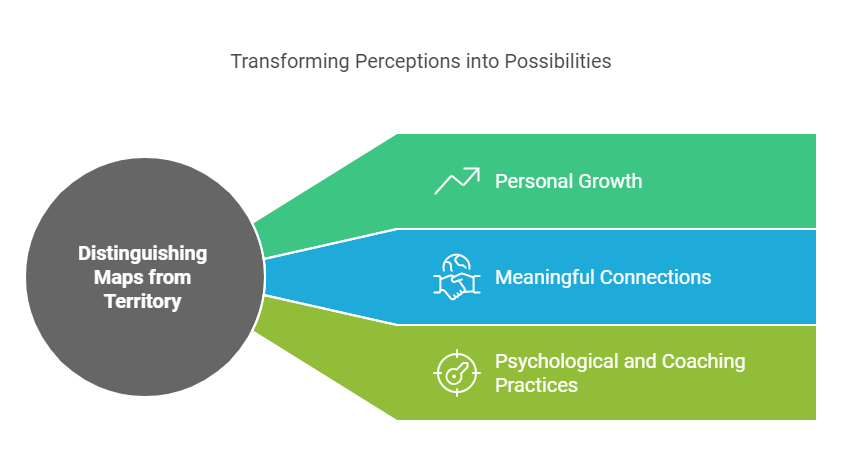
Ultimately, recognizing that map is not equal to territory is a powerful tool for personal growth and fulfillment. When we can distinguish our internal representations from objective reality, we open ourselves to new possibilities and a deeper understanding of the world around us.
By regularly questioning our assumptions and remaining open to alternative perspectives, we can navigate life’s challenges with greater clarity, resilience, and compassion. Embracing this concept allows us to let go of limiting beliefs, cultivate more meaningful connections, and fully embrace the richness of the present moment.
For psychologists and coaches, mastering techniques that help clients bridge the gap between their maps and the territory is essential for facilitating lasting change and personal transformation. By guiding clients through exercises that challenge distorted perceptions and align internal representations with reality, professionals can empower individuals to overcome obstacles, achieve their goals, and lead more fulfilling lives.
Conclusion: Continuing the Journey of Self-Discovery
In conclusion, the phrase map is not equal to territory is more than just a catchy adage; it’s a profound invitation to explore the depths of our perceptions and align ourselves with the true nature of reality. By embracing this concept, we can unlock a path to greater self-awareness, empathy, and fulfillment in all aspects of our lives.
Ultimately, the journey of self-discovery is an ongoing process, and the map is not equal to territory concept serves as a powerful reminder to continually question our assumptions, embrace new perspectives, and align our internal representations with the ever-evolving reality around us.

